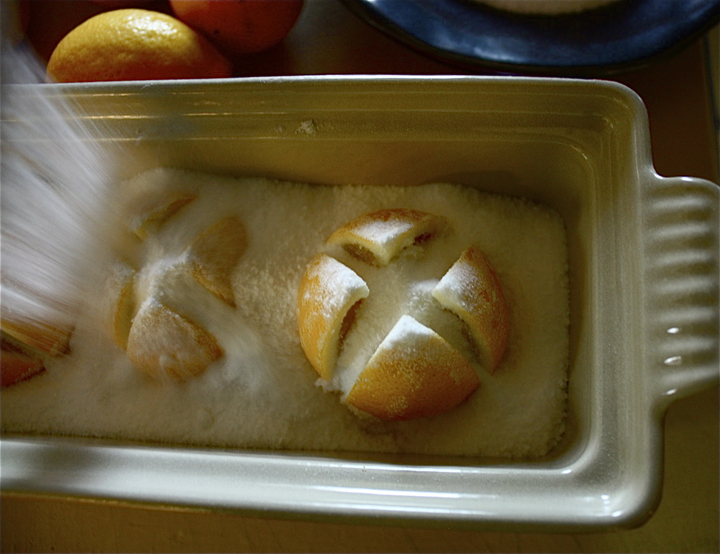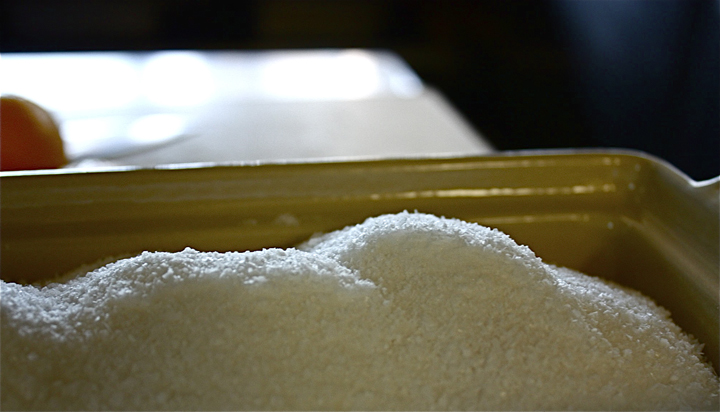Dish of the Week
Preserved Meyer Lemons
 I love apples, but truth be told if Eve had been any kind of cook when she was flirting with being thrown out of Eden, she would have given some thought to reaching for a lemon no matter how puckery that first bite might have been for Adam. Why? Because when it comes to cooking the things we comfort loving heathens love, citrus is all but indispensable. Without acid producing fruits like lemons and grapes (for vinegar), we’d drown in a sea of rich fatty flavors. Ryan’s a big fan of all things acidic ~ when we talk about food the words ‘brighten’ and ‘lift’ always go hand in hand with ‘rich,’ ‘buttery’ and ‘redolent.’
I love apples, but truth be told if Eve had been any kind of cook when she was flirting with being thrown out of Eden, she would have given some thought to reaching for a lemon no matter how puckery that first bite might have been for Adam. Why? Because when it comes to cooking the things we comfort loving heathens love, citrus is all but indispensable. Without acid producing fruits like lemons and grapes (for vinegar), we’d drown in a sea of rich fatty flavors. Ryan’s a big fan of all things acidic ~ when we talk about food the words ‘brighten’ and ‘lift’ always go hand in hand with ‘rich,’ ‘buttery’ and ‘redolent.’
He’s not alone in recognizing the merits of the humble lemon which has been around since biblical times, coming to the new world with Christopher Columbus. The recipe for preserving them ~ surely the simplest ways to extend their season ~ also hasn’t changed in centuries. In Elizabeth Raffield’s “The Experienced English Housekeeper,” written in 1769, she has a version of “lemon pickle” almost identical to one penned by an anonymous ‘Lady’ in Shakespearean times:
The lemons should be small, and with thick rinds: rub them with a piece of flannel; then slit them half down in four quarters, but not through to the pulp; fill the slits with salt hard pressed in, set them upright in a pan for four or five days, until the salt melts; turn them thrice a day in their own liquor, until tender.
 Meyer lemons, thought to be cross between a Lisbon lemon and a Mandarin (or a Eureka and an orange, take your pick), are perfect for preserving owing to their thin skins, which are shiny, smooth, small pored and edible. The pulp has a mild sweet flavor. Here in Sonoma, our season for them is early spring, but thanks to crazy ‘new’ weather patterns, when Myrna and Earl Fincher from Early Bird's Place showed up last week with their first crop, besides a quick of the head, no one was really surprised.
Meyer lemons, thought to be cross between a Lisbon lemon and a Mandarin (or a Eureka and an orange, take your pick), are perfect for preserving owing to their thin skins, which are shiny, smooth, small pored and edible. The pulp has a mild sweet flavor. Here in Sonoma, our season for them is early spring, but thanks to crazy ‘new’ weather patterns, when Myrna and Earl Fincher from Early Bird's Place showed up last week with their first crop, besides a quick of the head, no one was really surprised.
 Meyer’s are best when medium sized (in general they are less ellipsoidal than true lemons) and ripe when they turn a beautiful golden yellow color. To preserve, start by simply cross slitting through the skin until 1/2 to 3/4 a way down the body of the fruit.
Meyer’s are best when medium sized (in general they are less ellipsoidal than true lemons) and ripe when they turn a beautiful golden yellow color. To preserve, start by simply cross slitting through the skin until 1/2 to 3/4 a way down the body of the fruit.
 Position the fruit on a bed of large grain salt, a thumb's distance between each one. Kosher salt, made by compacting granular salt to produce larger irregularly shaped flakes, is the least expensive option, and perfect for preserving because while it dissolves easily, its wider surface area won't overwhelm the flavors of the fruit as it softens.
Position the fruit on a bed of large grain salt, a thumb's distance between each one. Kosher salt, made by compacting granular salt to produce larger irregularly shaped flakes, is the least expensive option, and perfect for preserving because while it dissolves easily, its wider surface area won't overwhelm the flavors of the fruit as it softens.
 Sift salt over the cut end of the lemons allowing it to fill every nook and cranny until they are covered. If you have a ceramic terrine lying around it’s shape makes the perfect preserving vessel as its thick walls keep the fermenting temperature constant.
Sift salt over the cut end of the lemons allowing it to fill every nook and cranny until they are covered. If you have a ceramic terrine lying around it’s shape makes the perfect preserving vessel as its thick walls keep the fermenting temperature constant.
 When the lemons are covered, replace the lid and store in a cool larder or at the back of the fridge. For a quick lemon pickle you can blanch the fruit to get the process started. Preserved lemons, sliced or cut into chunks, makes a delicious addition to any stew, especially those with poultry. They figure heavily in Indian and North African Cuisine. In Morocco they like to leave preserved lemons or “leems” for months before using them.
When the lemons are covered, replace the lid and store in a cool larder or at the back of the fridge. For a quick lemon pickle you can blanch the fruit to get the process started. Preserved lemons, sliced or cut into chunks, makes a delicious addition to any stew, especially those with poultry. They figure heavily in Indian and North African Cuisine. In Morocco they like to leave preserved lemons or “leems” for months before using them.
 But preserved lemons aren't just for savory dishes; they add a j’ne sais quois to sweet desserts, especially where you might expect a candied citrus peel. Perfect case in point is Octavio's newest winter dessert ~ Meyer Lemon Tart with house-made lightly spiced graham cracker crust. This week he's serving it with a gorgeous huckleberry sauce, crème frâiche ice cream, and, in pride of place on top, a translucent flourish of thinly sliced preserved Meyer lemons. Eat your heart out Eve.
But preserved lemons aren't just for savory dishes; they add a j’ne sais quois to sweet desserts, especially where you might expect a candied citrus peel. Perfect case in point is Octavio's newest winter dessert ~ Meyer Lemon Tart with house-made lightly spiced graham cracker crust. This week he's serving it with a gorgeous huckleberry sauce, crème frâiche ice cream, and, in pride of place on top, a translucent flourish of thinly sliced preserved Meyer lemons. Eat your heart out Eve.
In the Gallery
 The first pieces of Jordy Morgan's work we represented in the Studio were steel cage stone-filled sculptural pieces of sofas, chairs and standing vases. These monumental outdoor pieces played off a use of common indoor shapes and materials which took them to a new place. Extremely comfortable (though you don’t expect them to be), Jordy's stone sculpture/furniture manages to be both corporeal yet highly imaginative ~ physically heavy but spiritually light, if you follow my meaning. Rare is the day we don’t find guests from the restaurant migrating over from the main gardens to sit in these Flintstone looking armchairs, taking them in with childlike joy.
The first pieces of Jordy Morgan's work we represented in the Studio were steel cage stone-filled sculptural pieces of sofas, chairs and standing vases. These monumental outdoor pieces played off a use of common indoor shapes and materials which took them to a new place. Extremely comfortable (though you don’t expect them to be), Jordy's stone sculpture/furniture manages to be both corporeal yet highly imaginative ~ physically heavy but spiritually light, if you follow my meaning. Rare is the day we don’t find guests from the restaurant migrating over from the main gardens to sit in these Flintstone looking armchairs, taking them in with childlike joy.
 Two new pieces of Jordy's which arrived in the Gallery last week speak to yet a new direction for his work. The first is a bar-height table and four stools that look like they stepped out of Toy Story. Fabricated from a 1950’s steel shelving unit, with John Deere tractor-orange distressed skewed legs, the pieces work as a wonderful breakfast set or just as happily as an idiosyncratic desk for the office (whether or not you work for Pixar).
Two new pieces of Jordy's which arrived in the Gallery last week speak to yet a new direction for his work. The first is a bar-height table and four stools that look like they stepped out of Toy Story. Fabricated from a 1950’s steel shelving unit, with John Deere tractor-orange distressed skewed legs, the pieces work as a wonderful breakfast set or just as happily as an idiosyncratic desk for the office (whether or not you work for Pixar).
The second piece, though not without a tongue in cheek nod to the game of Tic Tac Toe, is a serious dining table, one of the most elegant pieces Jordy has ever done for us. Starting with a reclaimed 13" diameter heavy steel pipe, the artist has fabricated (perfectly pre-rusted) four-piece X casing legs. The dining surface, 1.5” thick, is satin finished Doug Fir.
Breakfast/Office Table 56"X 24.25" X 35.75" With four stools, $3600
XO Dining Table 8' x 24.25" wide x 30" $4200
Introducing... the $20 Barndiva Winter Brunch Special
 This Week begins a series of Winter Brunch Specials. First up a languorous Barndiva brunch that starts with a Bloody Mary (ok, or Mimosa), followed by our classic Barndiva Benny made with Costeaux Brioche Toast, two Early Bird's Place Organic Eggs, spinach, crispy pancetta and the yummiest (and possibly lightest) Hollandaise around. While this Benny was photographed solo, rest assured if you come in to claim it this coming Sunday, yours will come with roasted potatoes and a toy box salad. Say the magic words, "I eat the view!", and we'll throw in coffee as well.
This Week begins a series of Winter Brunch Specials. First up a languorous Barndiva brunch that starts with a Bloody Mary (ok, or Mimosa), followed by our classic Barndiva Benny made with Costeaux Brioche Toast, two Early Bird's Place Organic Eggs, spinach, crispy pancetta and the yummiest (and possibly lightest) Hollandaise around. While this Benny was photographed solo, rest assured if you come in to claim it this coming Sunday, yours will come with roasted potatoes and a toy box salad. Say the magic words, "I eat the view!", and we'll throw in coffee as well.
All text Jil Hales. All photos Jil Hales and Dawid Jaworski (unless otherwise noted).

